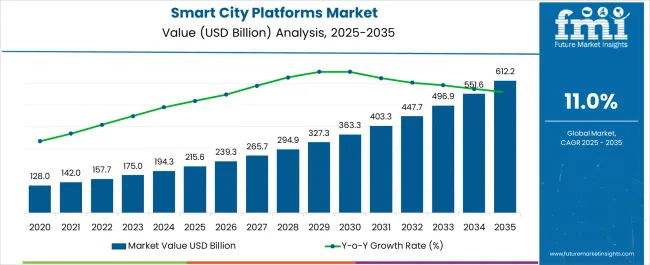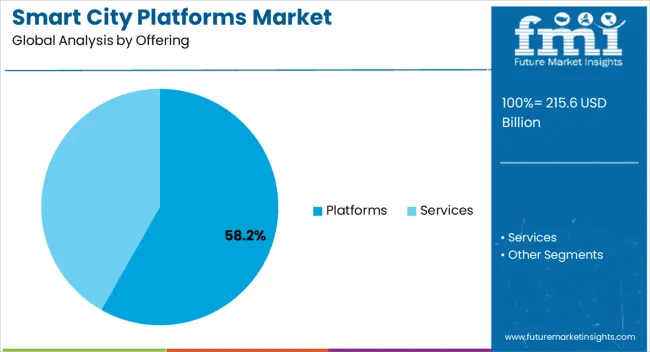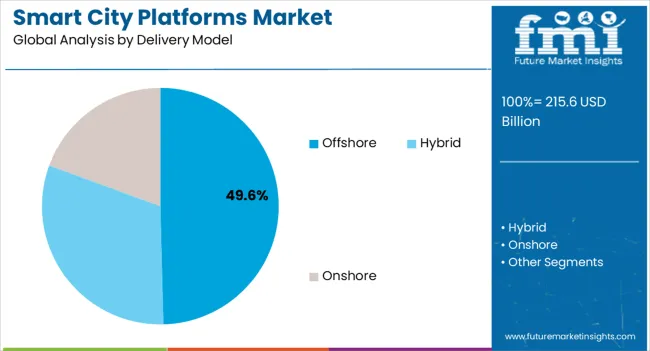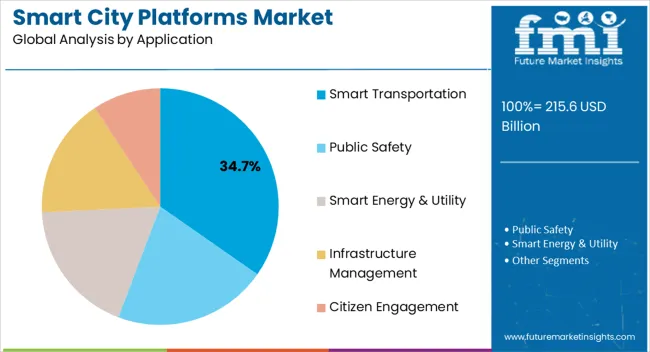The Smart City Platforms Market is estimated to be valued at USD 215.6 billion in 2025 and is projected to reach USD 612.2 billion by 2035, registering a compound annual growth rate (CAGR) of 11.0% over the forecast period.

| Metric | Value |
|---|---|
| Smart City Platforms Market Estimated Value in (2025 E) | USD 215.6 billion |
| Smart City Platforms Market Forecast Value in (2035 F) | USD 612.2 billion |
| Forecast CAGR (2025 to 2035) | 11.0% |
The smart city platforms market is expanding rapidly as urban centers adopt integrated digital solutions to improve efficiency, sustainability, and citizen engagement. Growing investments in IoT infrastructure, data analytics, and cloud based services are accelerating the deployment of platforms that connect devices, services, and applications across transportation, energy, healthcare, and governance systems.
Governments and municipal authorities are prioritizing platforms that enable real time data collection, predictive insights, and streamlined decision making. The push toward reducing carbon footprints, optimizing resource utilization, and improving mobility is further propelling adoption.
Advances in AI, 5G connectivity, and cybersecurity are supporting scalable and secure integration, strengthening confidence in platform based smart city models. With continued focus on sustainable urbanization, the market outlook is positive, and platforms will remain central to achieving smarter and more resilient urban ecosystems.

The platforms segment is projected to hold 58.20% of total market revenue by 2025 within the offering category, making it the dominant segment. Growth has been supported by the ability of platforms to integrate diverse data streams, provide centralized management, and enable interoperability across multiple smart city applications.
The scalability of platform solutions and their role in supporting both hardware and software ecosystems have made them highly attractive to municipalities. Additionally, platforms allow seamless integration of advanced analytics and artificial intelligence, enabling cities to respond proactively to urban challenges.
This combination of flexibility, interoperability, and decision support has reinforced the leadership of the platforms segment.

The offshore delivery model is expected to contribute 49.60% of total market revenue by 2025, positioning it as the leading segment within the delivery model category. This dominance is being driven by the availability of cost efficient expertise, rapid scalability of development resources, and access to specialized skills in emerging economies.
Offshore models have enabled faster deployment cycles and lower operational costs for municipal projects, which often operate under budget constraints. The model also supports 24x7 operations and global collaboration, ensuring faster resolution of technical challenges.
As governments and enterprises continue to seek efficiency in smart city implementation, the offshore delivery model remains a preferred choice for cost effectiveness and operational agility.

The smart transportation segment is forecasted to account for 34.70% of total market revenue by 2025 within the application category, establishing it as the leading application. The growth of this segment is driven by increasing urban congestion, rising environmental concerns, and the need for safer and more efficient mobility systems.
Deployment of connected infrastructure, real time traffic management, and smart public transport solutions are enhancing the efficiency of transportation networks. Integration of electric vehicle charging infrastructure and intelligent traffic systems has further strengthened adoption.
With cities prioritizing reduced emissions and improved commuter experiences, smart transportation has emerged as a cornerstone of smart city platforms, securing its leadership in the application category.
As per the smart city platforms market research by Future Market Insights - a market research and competitive intelligence provider, historically, from 2020 to 2025, the market value of the smart city platforms market increased at around 12% CAGR.
Platforms segment is predicted to expand at a CAGR of 9.5% through 2035. The fast pace of urbanization is reinforcing the notion of smart cities, offering promising development potential for the smart city platforms industry. Also, smart city platforms are crucial for improving urban infrastructure, operations, and applications, as well as other city-specific activities.
IoT connects businesses and governments to all smart opportunities, such as smart transportation, smart cities, and smart utilities, allowing them to obtain real-time location-based data. Further, IoT creates massive volumes of data in real time from multiple sources.
Deploying IoT solutions in smart city initiatives necessitates collaboration among several stakeholders, including telecom carriers, service providers, infrastructure providers, manufacturers, and the government sector. Moreover, the public-private partnership (PPP) model is most often used by governments throughout the world to encourage smart city initiatives. Also, technological breakthroughs, such as cloud, IoT, mobility, AI, and data communications, contribute to the infrastructure of smart cities.
The advancement of 5G and NB-IoT innovations, in particular, is likely to propel the smart city platforms industry forward. These technologies are utilized not only to improve residents' lives, but also in areas such as privacy, security, and environmental sustainability.
Another key reason impeding the growth of the smart city platforms market is security concerns around the introduction of smart devices in cities. Further, smart city systems, like any other linked technology, rely on networking for data transfer and are thus subject to compromise. Factors that are driving the market growth further include:
During the projected period, North America held a notable share in the global smart city platforms market with a market size of USD 145 billion. The regional market is anticipated to expand at a CAGR of 9.6%.
Region's network operators continuously invest in upgrading and expanding their telecom networks, as well as transitioning to 5G infrastructure by maximizing innovations such as cloud-edge computation technology and network slicing, thereby accelerating the acceptance of smart city systems and platforms for low-cost and tactical urban management.
The entrepreneurial environment in North America is expanding fast compared to other countries. Rapid digitization across several verticals, rising usage of smart connected devices, and growing technical breakthroughs have all contributed to the development of the smart city platforms industry in the region.
The United States is expected to hold a notable market share of USD 612.2 billion by the end of 2035 with an expected CAGR of 9.6% by the end of 2035.
Factors such as the widespread use of smart city services and solutions, significant ICT investment by government organizations, and rising demand for linked solutions are driving the market growth in the country.
Governments in several locations in the United States are preparing to invest considerably to improve their infrastructure and fully capitalize on the benefits of IoT. Moreover, the presence of leading industry competitors including Microsoft, IBM, Cisco Systems, and GE Current in the area is expected to open new development opportunities for the regional marketplaces.
Additionally, increased internet penetration helps to complement the notion of smart city platforms by allowing IoT connections, which contribute significantly to smart city platforms. KT's innovative technology, Giga Wire, has been utilized in the United States.
Las Vegas has implemented Digital Twin technology, following the footsteps of New York City, intending to achieve zero carbon emissions. Following that, Las Vegas is planning to leverage the power of advanced IoT, 5G networking, and other technologies to improve air quality, noise pollution, mobility, water management, and pollutants from key structures.
The platforms segment is forecasted to expand at a high CAGR of around 9.5% from 2025 to 2035. Analytics, performance management, remote asset monitoring, decision support, and presentation components are all performed by smart city platforms.
Most technologically savvy cities utilize the Internet of Things system to analyze municipal infrastructure, regulate everything including water and air quality, traffic flows, and parking, and use the resultant smart data to address longer-term environmental planning issues.
The smart city platforms provide a framework enabling urban infrastructure, technologies, and operations, as well as a variety of city-specific tasks. Also, due to the sheer flexibility and incorporation of other smart solutions, one of the important reasons projected to fuel the rising demand in cities is giving precedence to platform providers over standalone smart solutions.
The Hybrid segment is forecasted to expand at a significant CAGR of around 9% between 2025 and 2035. The solution is deployed at the customer's location under the hybrid delivery model, which is comparable to the offshore approach.
Maintenance and upgrades are performed at the customer's location, while other aspects of the services are managed remotely from the vendor's location. Due to the connection management and security platforms, the hybrid delivery model is widely used.
The advantages of both on-site and offshore delivery approaches may be used in this delivery strategy. Furthermore, hybrid solutions provide a broad array of functions and essential characteristics, fueling total hybrid solution adoption during the projected period. Additionally, this delivery approach combines the advantages of onshore and offshore delivery. For instance,
The research discusses key trends in the smart city platform industry as well as inorganic and organic growth methods. Moreover, various firms are focusing on organic growth strategies such as product approvals, and new product releases.
The strategy noted in the sector included mergers and acquisitions, partnerships, and collaborations. These measures have paved the way for market players to grow their businesses and strengthen their distribution networks.
Recent Developments in the Smart City Platform Market
| Report Attributes | Details |
|---|---|
| Growth Rate | CAGR of 11% from 2025 to 2035 |
| Base Year for Estimation | 2025 |
| Historical Data | 2020 to 2025 |
| Forecast Period | 2025 to 2035 |
| Global Smart City Platforms Market Size (2025) | USD 215.6 billion |
| Global Smart City Platforms Market Size (2035) | USD 612.2 billion |
| Quantitative Units | Revenue in USD million and CAGR from 2025 to 2035 |
| Report Coverage | Revenue Forecast, Volume Forecast, Company Ranking, Competitive Landscape, Growth Factors, Trends, and Pricing Analysis |
| Segments Covered | Offering, Delivery Model, Application, Region |
| Regions Covered | North America; Latin America; Western Europe; Eastern Europe; Asia Pacific excluding Japan; Japan; The Middle East and Africa |
| Key Countries Profiled | The United States, Canada, Brazil, Mexico, Germany, The United Kingdom, France, Spain, Italy, Poland, Russia, Czech Republic, India, Bangladesh, Australia, New Zealand, China, Japan, South Korea, GCC Countries, South Africa, Israel |
| Customization | Available Upon Request |
The global smart city platforms market is estimated to be valued at USD 215.6 billion in 2025.
The market size for the smart city platforms market is projected to reach USD 612.2 billion by 2035.
The smart city platforms market is expected to grow at a 11.0% CAGR between 2025 and 2035.
The key product types in smart city platforms market are platforms, connectivity management platform, integration platform, device management platform, security platform, data management platform, services, professional services and managed services.
In terms of delivery model, offshore segment to command 49.6% share in the smart city platforms market in 2025.






Full Research Suite comprises of:
Market outlook & trends analysis
Interviews & case studies
Strategic recommendations
Vendor profiles & capabilities analysis
5-year forecasts
8 regions and 60+ country-level data splits
Market segment data splits
12 months of continuous data updates
DELIVERED AS:
PDF EXCEL ONLINE
Smart Digital Valve Positioner Market Forecast and Outlook 2025 to 2035
Smart Card IC Market Size and Share Forecast Outlook 2025 to 2035
Smart-Tag Inlay Inserters Market Analysis - Size and Share Forecast Outlook 2025 to 2035
Smart Wheelchair Market Forecast and Outlook 2025 to 2035
Smart TV Market Forecast and Outlook 2025 to 2035
Smart/AI Toy Market Size and Share Forecast Outlook 2025 to 2035
Smart Locks Market Size and Share Forecast Outlook 2025 to 2035
Smart Sprinkler Controller Market Size and Share Forecast Outlook 2025 to 2035
Smart Indoor Gardening System Market Size and Share Forecast Outlook 2025 to 2035
Smart Building Delivery Robot Market Size and Share Forecast Outlook 2025 to 2035
Smart Watch Market Size and Share Forecast Outlook 2025 to 2035
Smart Label Market Size and Share Forecast Outlook 2025 to 2035
Smart Mat Market Size and Share Forecast Outlook 2025 to 2035
Smart Water Management Market Size and Share Forecast Outlook 2025 to 2035
Smart Built-In Kitchen Appliance Market Size and Share Forecast Outlook 2025 to 2035
Smart Cold Therapy Machine Market Size and Share Forecast Outlook 2025 to 2035
Smart Personal Assistance Devices Market Size and Share Forecast Outlook 2025 to 2035
Smart Speaker Market Size and Share Forecast Outlook 2025 to 2035
Smart Vehicle Architecture Market Size and Share Forecast Outlook 2025 to 2035
Smart Doorbell Market Size and Share Forecast Outlook 2025 to 2035

Thank you!
You will receive an email from our Business Development Manager. Please be sure to check your SPAM/JUNK folder too.
Chat With
MaRIA